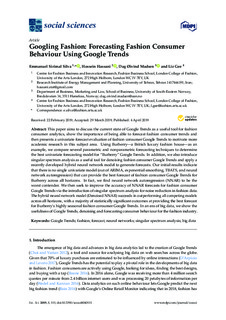| dc.contributor.author | Silva, Emmanuel Sirimal | |
| dc.contributor.author | Hassani, Hossein | |
| dc.contributor.author | Madsen, Dag Øivind | |
| dc.contributor.author | Gee, Liz | |
| dc.date.accessioned | 2019-04-10T10:56:51Z | |
| dc.date.available | 2019-04-10T10:56:51Z | |
| dc.date.created | 2019-03-29T16:07:40Z | |
| dc.date.issued | 2019 | |
| dc.identifier.citation | Social Sciences, 2019, 8(4). | nb_NO |
| dc.identifier.issn | 2076-0760 | |
| dc.identifier.uri | http://hdl.handle.net/11250/2594029 | |
| dc.description | Licensee MDPI, Basel, Switzerland. This article is an open access article distributed under the terms and conditions of the Creative Commons Attribution (CC BY) license. | nb_NO |
| dc.description.abstract | This paper aims to discuss the current state of Google Trends as a useful tool for fashion consumer analytics, show the importance of being able to forecast fashion consumer trends and then presents a univariate forecast evaluation of fashion consumer Google Trends to motivate more academic research in this subject area. Using Burberry—a British luxury fashion house—as an example, we compare several parametric and nonparametric forecasting techniques to determine the best univariate forecasting model for “Burberry” Google Trends. In addition, we also introduce singular spectrum analysis as a useful tool for denoising fashion consumer Google Trends and apply a recently developed hybrid neural network model to generate forecasts. Our initial results indicate that there is no single univariate model (out of ARIMA, exponential smoothing, TBATS, and neural network autoregression) that can provide the best forecast of fashion consumer Google Trends for Burberry across all horizons. In fact, we find neural network autoregression (NNAR) to be the worst contender. We then seek to improve the accuracy of NNAR forecasts for fashion consumer Google Trends via the introduction of singular spectrum analysis for noise reduction in fashion data. The hybrid neural network model (Denoised NNAR) succeeds in outperforming all competing models across all horizons, with a majority of statistically significant outcomes at providing the best forecast for Burberry’s highly seasonal fashion consumer Google Trends. In an era of big data, we show the usefulness of Google Trends, denoising and forecasting consumer behaviour for the fashion industry. | nb_NO |
| dc.language.iso | eng | nb_NO |
| dc.relation.uri | https://www.mdpi.com/2076-0760/8/4/111 | |
| dc.rights | Navngivelse 4.0 Internasjonal | * |
| dc.rights.uri | http://creativecommons.org/licenses/by/4.0/deed.no | * |
| dc.title | Googling Fashion: Forecasting Fashion Consumer Behaviour using Google Trends | nb_NO |
| dc.type | Journal article | nb_NO |
| dc.type | Peer reviewed | nb_NO |
| dc.description.version | publishedVersion | nb_NO |
| dc.rights.holder | © 2019 by the authors | nb_NO |
| dc.source.pagenumber | 1-23 | nb_NO |
| dc.source.volume | 8 | nb_NO |
| dc.source.journal | Social Sciences | nb_NO |
| dc.source.issue | 4 | nb_NO |
| dc.identifier.doi | https://doi.org/10.3390/socsci8040111 | |
| dc.identifier.cristin | 1689002 | |
| cristin.unitcode | 222,57,3,0 | |
| cristin.unitname | Institutt for økonomi, markedsføring og jus | |
| cristin.ispublished | true | |
| cristin.fulltext | original | |
| cristin.qualitycode | 1 | |

